We have had a wet June to say the least, just as the NOAA outlook predicted we would have. Pam Knox has shared with us the outlooks for July through September and it is looking bout how June was for us, see her update on that below. We have some very late planted fields in Appling County, the last bit of our planting wrapped up the end of last week, as far as I am aware. With as late as some cotton is planted in the area we may want to consider altering our Nitrogen management plans to speed up the growth of the cotton in those late planted fields. I would consider earlier applications of side dress N, preferably around squaring rather than at bloom, and at planting I would consider applying a minimum of a third to a half N instead of 1/4. Still no Southern Corn Rust to be found in Appling County, there are more updates on that and other plant diseases from Dr. Kemerait further in this newsletter. Georgia Cotton Commission has put out a lot of good information from UGA State specialists the past couple of weeks, you can find those articles here. Also, GCC Mid-Year Meeting, July 23rd, in Statesboro, GA, come out and support each other, register using the link below.
https://docs.google.com/forms/d/e/1FAIpQLSd2gwNaofTP4fVp9Dfgn2oadhnTiHy7B6Yo199vd2AmgeRtUQ/viewform
Topics in This Newsletter:
- July through September 2025 expected to be warmer and wetter than usual in most of the Southeast (Pam Knox, UGA Climatologist)
- For the Doubting Thomas (Dr. Eric Prostko, UGA Weed Specialist)
- Row Crop Disease Update (Dr. Bob Kemerait, UGA Plant Pathologist)
- Chlorothalonil Alternatives and Tank Mixing w/ Provost Silver (Dr. Bob Kemerait, UGA Plant Pathologist)
- Ext PA and Irrigation Blog Post (Dr. Wesley Porter, UGA Precision Ag and Irrigation Specialist)
- Talkin’ Cotton Podcast (UGA Cotton Team)
July through September 2025 expected to be warmer and wetter than usual in most of the Southeast (Pam Knox)
NOAA’s Climate Prediction Center released their updated monthly and seasonal climate outlooks earlier this week. They show that the July-September period is expected to be warmer than usual although July alone has equal chances of near, above, and below normal temperature in spite of the end of June being very hot. The same periods are also expected to be wetter than normal for most of the region. This means that drought is not likely to be an issue, but short-term water deficits could still occur, especially if it stays hot.
I attribute a lot of the extra rainfall to be due to the likely active tropical pattern we are expected to see later in the year. Don’t be fooled by the lack of storms so far this year. Many of the most active seasons got a late start and the Gulf of Mexico is plenty warm, so once the Saharan dust decreases, we can expect to see some more action, although nothing through the first week of July is predicted right now.
The early predictions for the last quarter of 2025 and the first quarter of 2026 show a pattern similar to last year, reflecting the likelihood of neutral or weak La Nina conditions then. You can see those maps



For the Doubting Thomas (Prostko)
Here is a quick picture from my research plots earlier today. Further proof that herbicides work well when applied on time. Generally, I do not have any preference for what Group 15 herbicide is used in this EPOST + POST program (Anthem Flex, Dual Magnum, Enversa, Outlook, Warrant, or Zidua). But, I would prefer that our growers not tank-mix Anthem Flex with Cadre + Cobra (POST) at this time (i.e., I need more data). Also, please keep in mind that these are average prices and prices may be more or less depending upon the grower.

If you need more info about herbicide mechanisms of action (Groups), check this out from the Weed Science Society of America:
https://wssa.net/wp-content/uploads/WSSA-Mechanism-of-Action.pdf
Row Crop Disease Update (Dr. Bob Kemerait, UGA Plant Pathologist)
Looks like southern rust, not southern rust

Pic comes from Cody in Randolph Co, also got similar pics from Jeremy in Colquitt Co and consultant Caleb Trough. Though the orange color here often confuses folks with southern corn rust, it is not. Southern corn rust, when wiped on a light colored shirt, will leave an orange streak; this will not. This symptom invariably comes on sometime after silking. For a while we, myself included, believed this was an abiotic disorder. More recent work by Dr David Langston in Virginia Indicates there may actually be a fungal pathogen involved which responds to some fungicides. However, to date this response and the symptom have not been tied to disease loss.
Southern Corn Rust in Bacon County
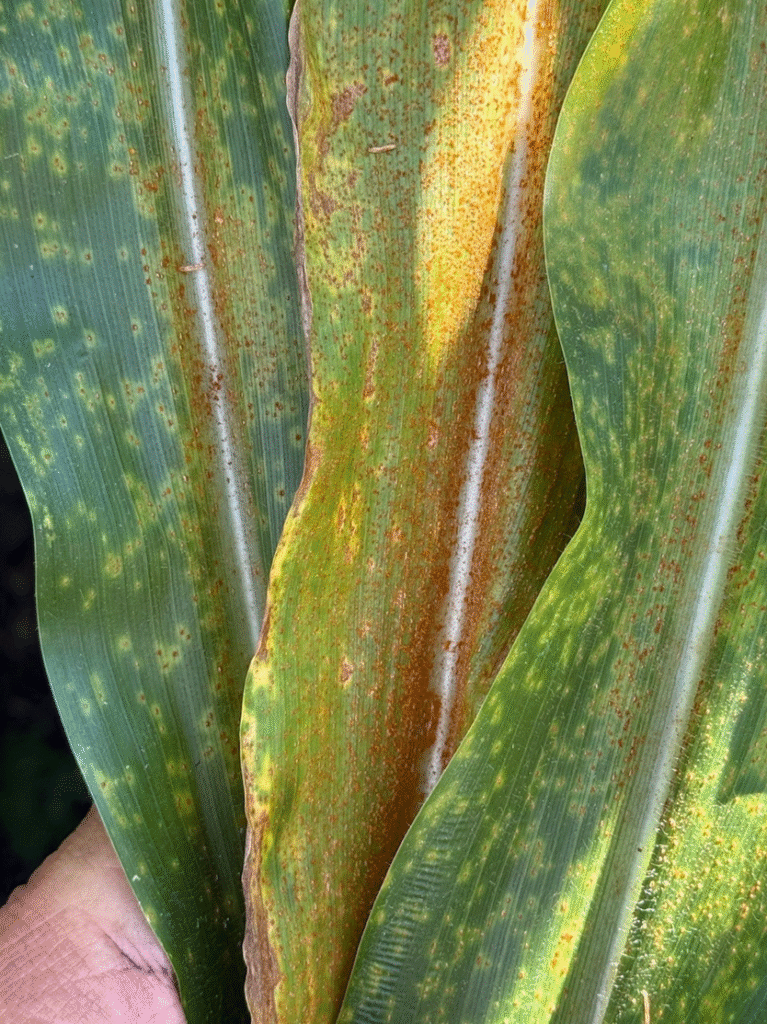
Pic comes from consultant in Bacon Co and our buddy there, Zach W, is confirming the diagnosis this morning. Almost assuredly southern corn rust, this comes from a field that had not been sprayed with a fungicide. Do all corn fields in Georgia need To be treated with a fungicide? No they don’t. Young gun Dr Camp Hand posted on my twitter last night, “if you are scared, spray.” I appreciate the sentiment. But there is more to it than that. I have tremendous respect for rust. I have seen many times what it can do to you. Even Wallace Anderson way up in Gilmer Co with Anna has said southern rust hurts his yield sometimes. Like protecting peanuts from white mold, protecting corn from southern rust is an important consideration. And it is hard to play “catch up” with rust once it is loose.
TSWV in Peanut
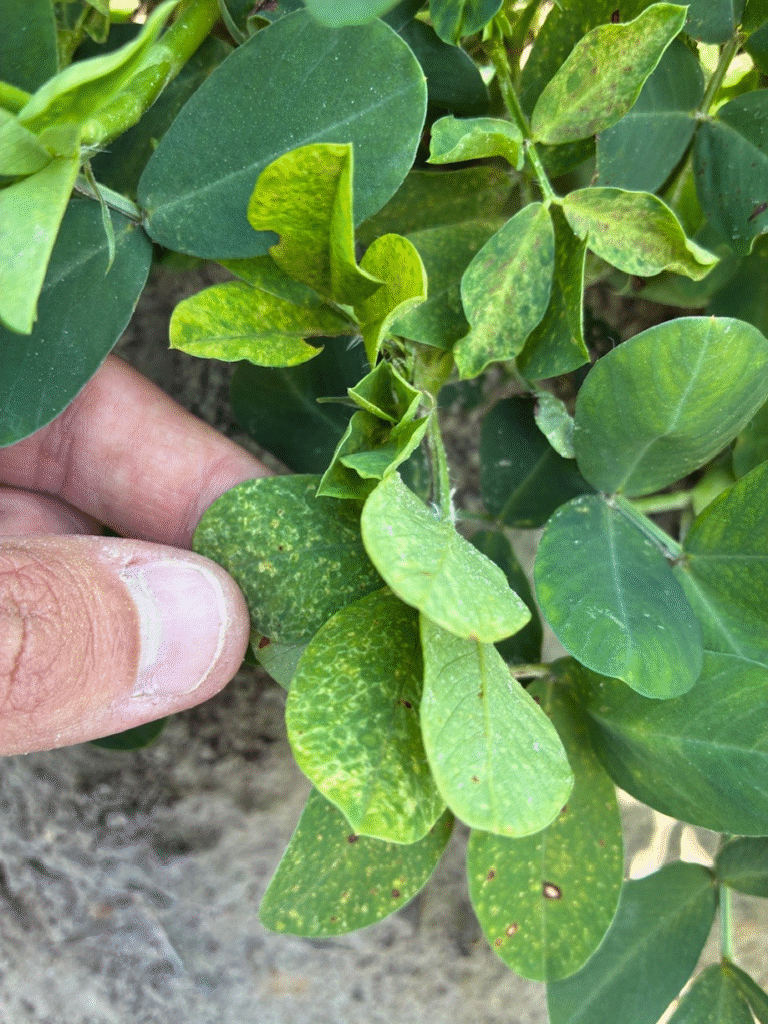
False White Mold in Peanut
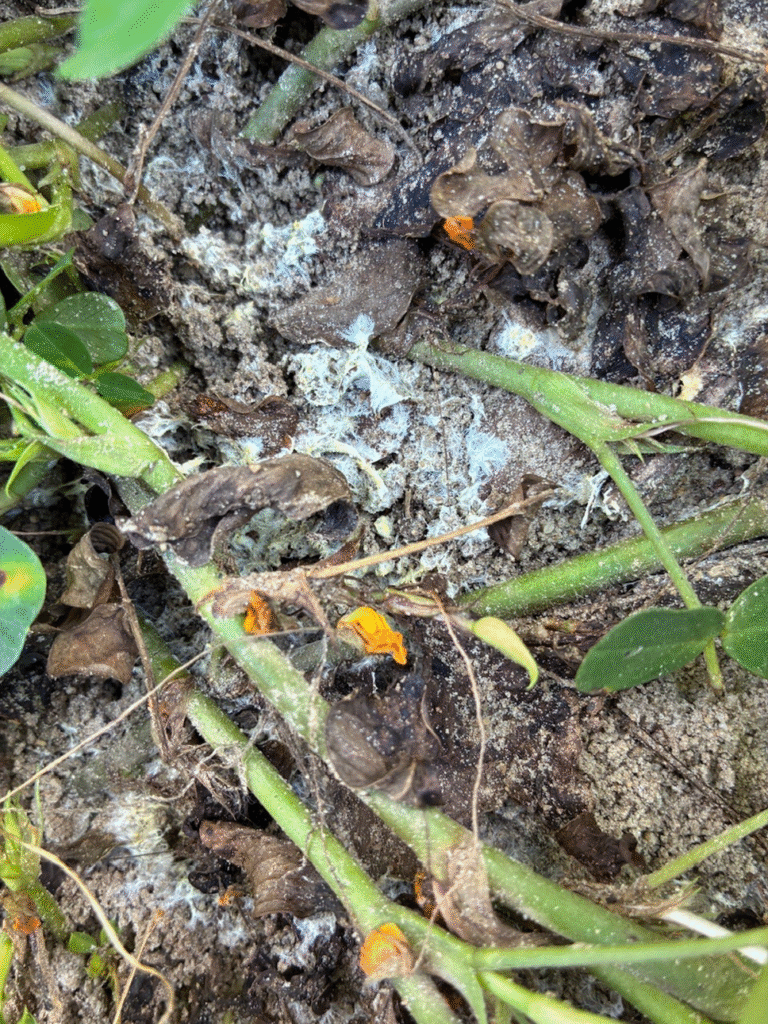
False white mold (Phaberochaete) on peanut. Looks like white mold disease, but isn’t. Note orange growth on white mycelia. Kinda like scarlet king snakes and coral snakes- “red on black, friend of Jack; black on yellow, kill a fellow”. And so it goes.
CLRDV-Induced Bronze Wilt in Cotton
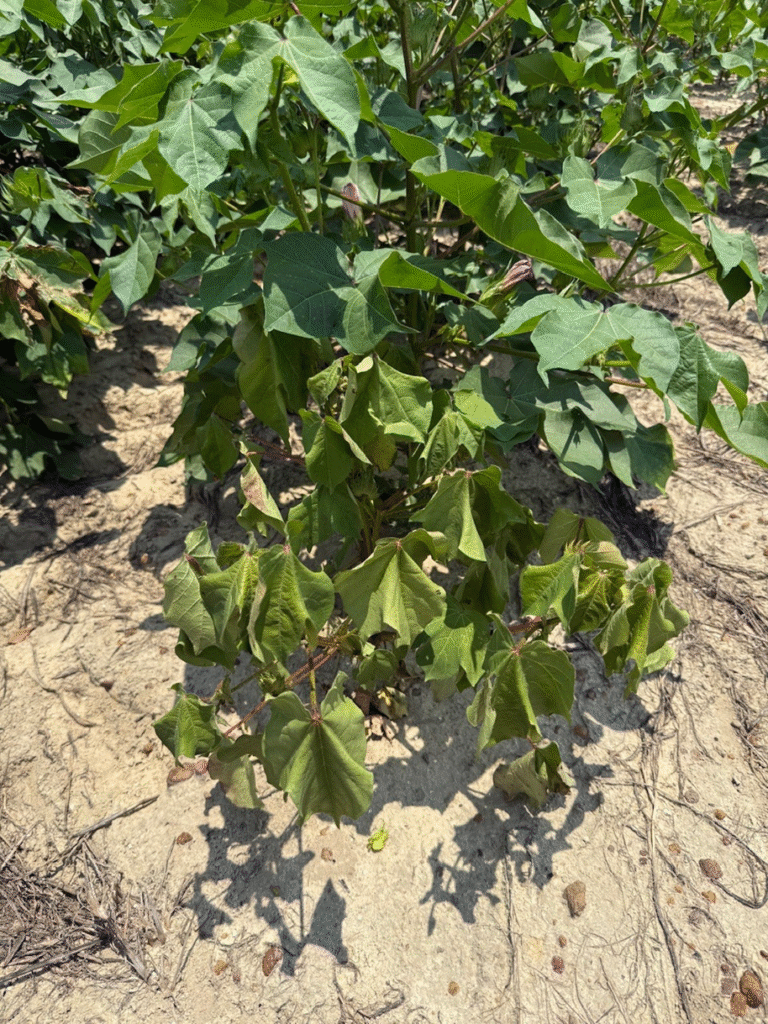
Pic from Dr Camp Hand- it is beginning to show up again under the recent blistering hot and dry conditions in southern Georgia. What we are calling “CLRDV-induced bronze wilt”. And guess what??? It is showing up in the varieties we told growers to watch. Go figure.
Fusarium Wilt and Sting Nematodes
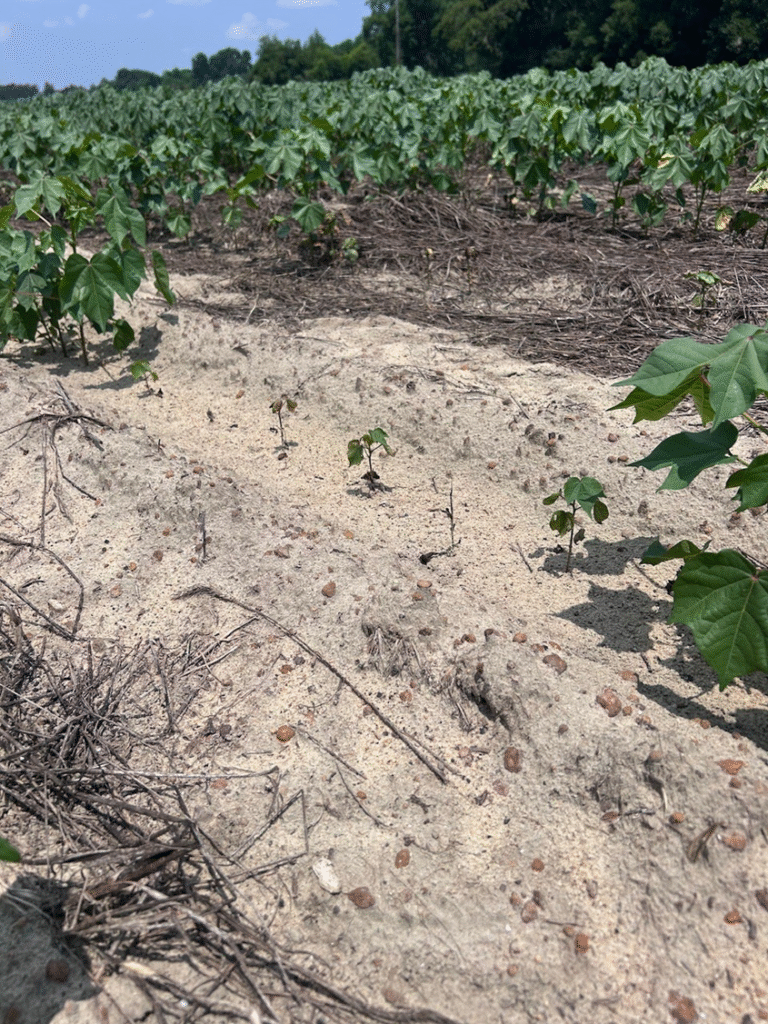
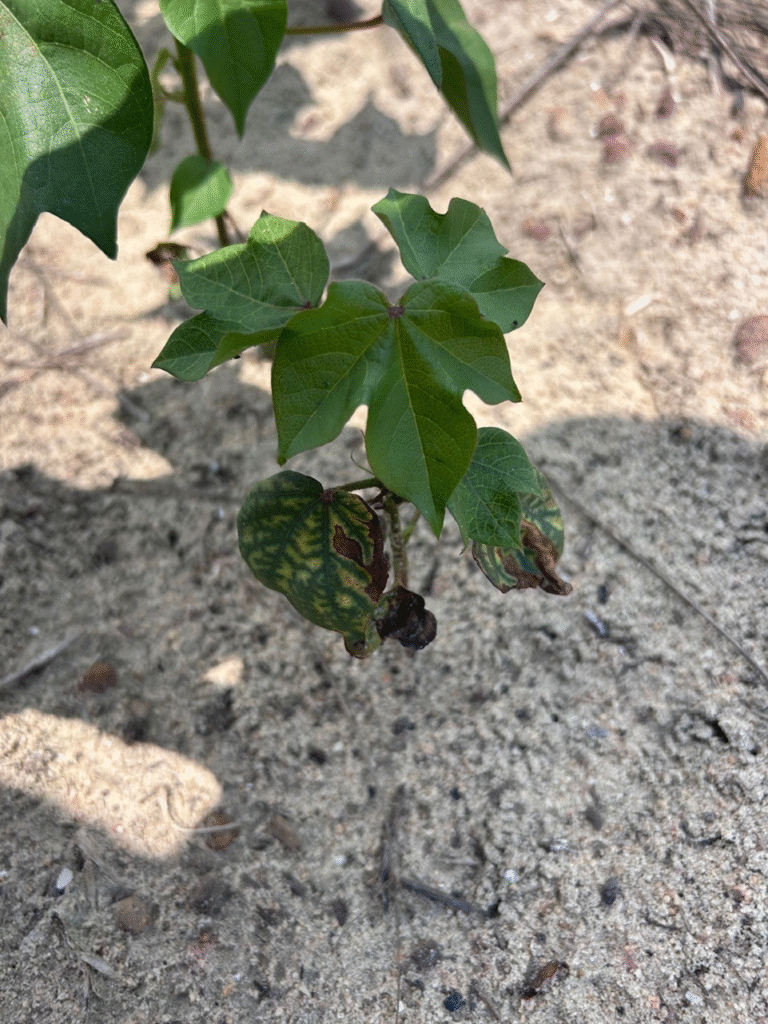
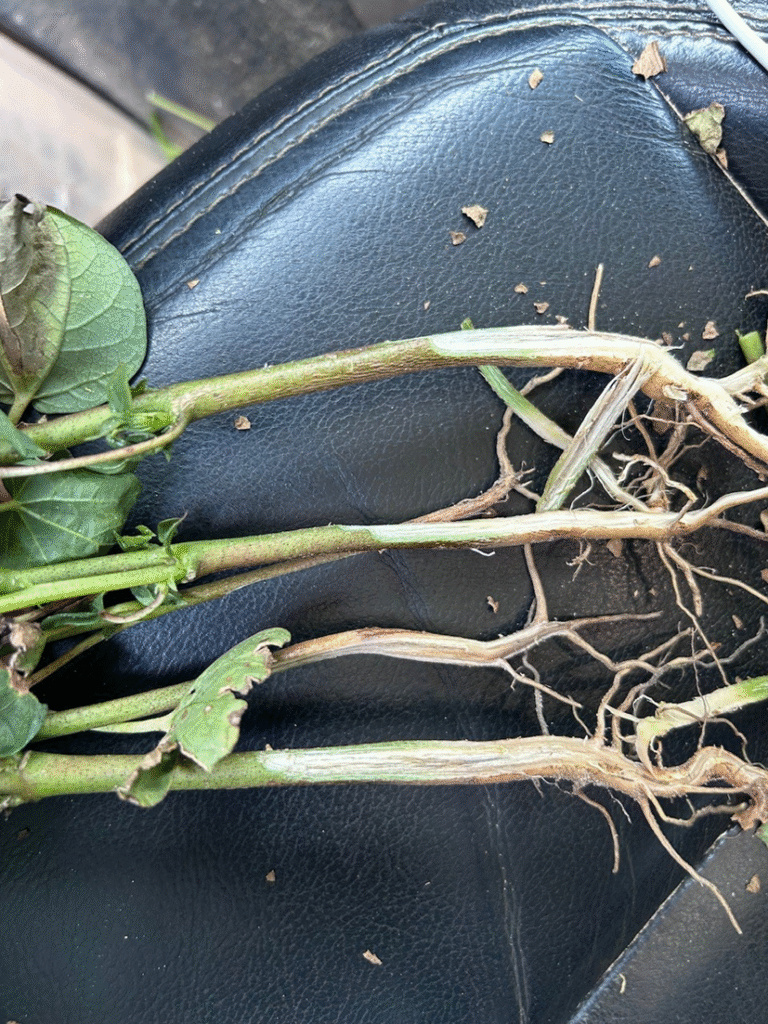
Pics from our good friend Dr Jared Whitaker. Fusarium wilt of cotton showing up, most likely in tag team with sting nematodes. Why? Because in Georgia Fusarium wilt of cotton requires a nematode partner. As Jared noted there was no root galling, the issue is either reniform or sting nematodes. Looking at the sandy soil and with my experience, much more likely stingers. Note the vascular discoloration of the slit stem, the interveinal chlorosis of the affected leaves, and the stunted plants. Eye candy. And a terrible problem in the field. Growers MUST recognize this disease and avoid spreading infested soil. Believe me. Please.
Northern Corn Leaf Blight
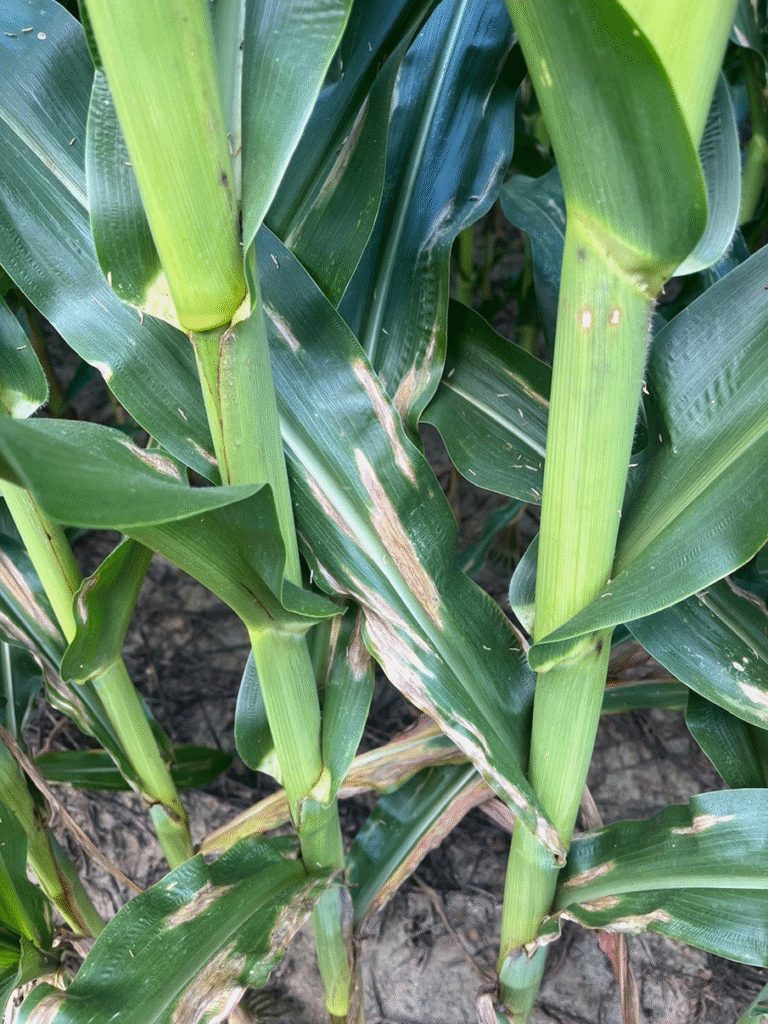
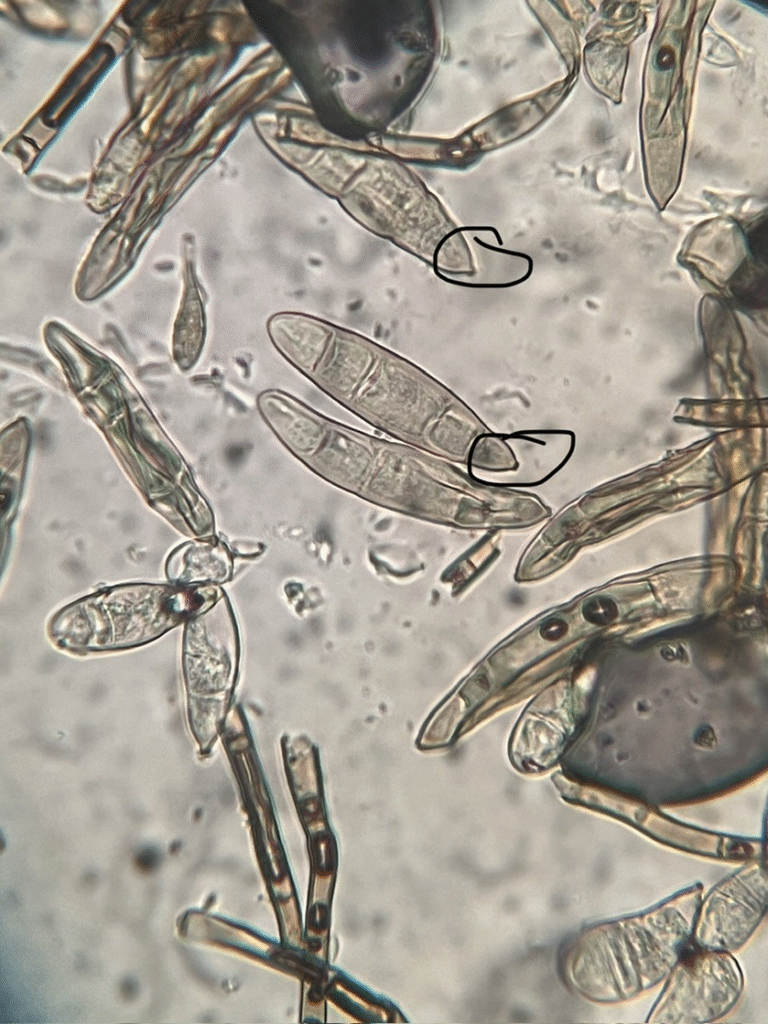
Pics from Hunt in Ben Hill Co. This is northern corn leaf blight, Exserohilum turcicum, as Hunt so ably proved with the microscope image. (Note the pronounced scar at one end of the spore; this distinguishes it from Bipolaris and “southern corn leaf blight” and “northern corn leaf spot”.). We commonly find bits of northern corn leaf blight in most fields, but we generally do not spray for it because of good disease resistance in our varieties. However, the plant pictured here from Hunt is covered up with beaucoup lesions. Obviously THIS plant is NOT resistant; a field like this would absolutely need a fungicide application to protect yield.
Chlorothalonil Alternatives and Tank Mixing w/ Provost Silver (Dr. Bob Kemerait, UGA Plant Pathologist)
Had a question about replacement for chlorothalonil in a peanut fungicide program. An interesting question as I am not sure why the grower would want to replace chlorothalonil. But here goes..
1. Early season, Absolute Maxx or Aproach Prima can replace a chlorothalonil application
2. Early season, an application of Lucento or Priaxor can replace two chlorothalonil applications
3. Later Provost Silver (and generic formulations) or Provysol + teb more than replaces chlorothslonil
4. Specific Albert Culbreath tested and approved formulations of micronized sulfur can replace chlorothslonil when tank mixed with 1) Excalia, 2) Elatus, 3) Umbra, 4) azoxystrobin, 5) tebuconazole, 6) pyrsclostrobin
5) chlorothalonil can be replaced by Alto on tank mixes with Excalia and Elatus
6. Dodine/Elast fungicide is a replacement for chlorothslonil for peanut leaf spot control.
7. Tetraconazole (NOT same as tebuconazole) is also a leaf spot material (for example Domark) that can be applied at the higher rate in a similar way Alto can be used. I really like Tetraconazole + chlorothalonil, but there are other ways it can be used.
However- we truly cannot replace chlorothslonil from our peanut fungicide programs as it is the foundation of our plans to manage resistance for leaf spot to our other single-site mode of action fungicides.
Also, had a grower email me yesterday. He mixed Provost Silver with boron and a few other things in his tank and it didn’t mix well, but he ended up being able to spray. He asked my thoughts. 1) I do not advise mixing anything with Provost Silver. 2) as he was able to eventually spray the mixture, I am hopeful he got some disease control from the Provost Silver, but probably not complete control. I advised him to go back in after 10 days as a safeguard.
Ext PA and Irrigation Blog Post – Wesley M Porter
Here is the link to this weeks Extension Precision Ag and Irrigation Blog Post. I would like to say a huge thank you to Brian Mathis, Regional Sales Manager, TeeJet Technologies Southeast for his help with this newsletter. I do not know anyone with more knowledge on sprayer tips and associate technology than Brian. I hope you find the information in this blog post helpful.
Talkin’ Cotton Podcast (UGA Cotton Team)
Below is a link to season 2, episode 13 of the Talkin’ Cotton Podcast, which is a discussion on later plantings and thoughts entering bloom.
Remember, this link takes you directly to buzzsprout, but the podcast can be found on Apple Podcasts, Spotify, and Amazon Music as well.
https://www.buzzsprout.com/2350262/episodes/17365541
All About The Pod Podcast (UGA Peanut Team)

EPISODE 18, Season 3 — Late June Crop Conditions and Pest Management Comments
In this episode, Drs. Scott Monfort, Mark Abney, Bob Kemerait, and Eric Prostko discussed the current crop situation and pest management options. If you have any questions or would like to suggest topics for discussion on a future episode, contact your local UGA Extension agent.